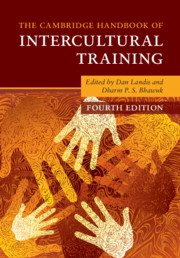29 results
Reviews
-
- Book:
- The Cambridge Handbook of Intercultural Training
- Published online:
- 18 September 2020
- Print publication:
- 27 August 2020, pp ii-ii
-
- Chapter
- Export citation
Appendix B - Critical Incident “Sakhalin Joint Venture”
- from 16 - Russian Cultural Patterns and Intercultural Training
-
- Book:
- The Cambridge Handbook of Intercultural Training
- Published online:
- 18 September 2020
- Print publication:
- 27 August 2020, pp 536-539
-
- Chapter
- Export citation
Editors and Contributors
-
- Book:
- The Cambridge Handbook of Intercultural Training
- Published online:
- 18 September 2020
- Print publication:
- 27 August 2020, pp xiv-xxix
-
- Chapter
- Export citation
Figures
-
- Book:
- The Cambridge Handbook of Intercultural Training
- Published online:
- 18 September 2020
- Print publication:
- 27 August 2020, pp xii-xii
-
- Chapter
- Export citation
Preface
-
- Book:
- The Cambridge Handbook of Intercultural Training
- Published online:
- 18 September 2020
- Print publication:
- 27 August 2020, pp xxxv-xxxvi
-
- Chapter
- Export citation
Frontispiece
-
- Book:
- The Cambridge Handbook of Intercultural Training
- Published online:
- 18 September 2020
- Print publication:
- 27 August 2020, pp vii-viii
-
- Chapter
- Export citation
17 - Indian Psychology and Intercultural Training
- from Part III - Indigenous Psychology and Intercultural Training
-
-
- Book:
- The Cambridge Handbook of Intercultural Training
- Published online:
- 18 September 2020
- Print publication:
- 27 August 2020, pp 540-563
-
- Chapter
- Export citation
1 - Introduction and Theoretical Framework
-
-
- Book:
- The Cambridge Handbook of Intercultural Training
- Published online:
- 18 September 2020
- Print publication:
- 27 August 2020, pp 1-36
-
- Chapter
- Export citation
Part IV - New Interdisciplinary Approaches to Intercultural Training
-
- Book:
- The Cambridge Handbook of Intercultural Training
- Published online:
- 18 September 2020
- Print publication:
- 27 August 2020, pp 599-700
-
- Chapter
- Export citation
Copyright page
-
- Book:
- The Cambridge Handbook of Intercultural Training
- Published online:
- 18 September 2020
- Print publication:
- 27 August 2020, pp iv-iv
-
- Chapter
- Export citation
Foreword
-
- Book:
- The Cambridge Handbook of Intercultural Training
- Published online:
- 18 September 2020
- Print publication:
- 27 August 2020, pp xxx-xxxiv
-
- Chapter
- Export citation
Part V - Summing Up
-
- Book:
- The Cambridge Handbook of Intercultural Training
- Published online:
- 18 September 2020
- Print publication:
- 27 August 2020, pp 701-721
-
- Chapter
- Export citation
Part II - Practice of Intercultural Training
-
- Book:
- The Cambridge Handbook of Intercultural Training
- Published online:
- 18 September 2020
- Print publication:
- 27 August 2020, pp 355-494
-
- Chapter
- Export citation
Part III - Indigenous Psychology and Intercultural Training
-
- Book:
- The Cambridge Handbook of Intercultural Training
- Published online:
- 18 September 2020
- Print publication:
- 27 August 2020, pp 495-598
-
- Chapter
- Export citation
Part I - Theoretical Foundations of Intercultural Training
-
- Book:
- The Cambridge Handbook of Intercultural Training
- Published online:
- 18 September 2020
- Print publication:
- 27 August 2020, pp 37-354
-
- Chapter
- Export citation
2 - Harry Triandis’s Contributions to Intercultural Training as a Field of Research
- from Part I - Theoretical Foundations of Intercultural Training
-
-
- Book:
- The Cambridge Handbook of Intercultural Training
- Published online:
- 18 September 2020
- Print publication:
- 27 August 2020, pp 39-59
-
- Chapter
- Export citation
4 - Culture Theories and Intercultural Training
- from Part I - Theoretical Foundations of Intercultural Training
-
-
- Book:
- The Cambridge Handbook of Intercultural Training
- Published online:
- 18 September 2020
- Print publication:
- 27 August 2020, pp 164-191
-
- Chapter
- Export citation

The Cambridge Handbook of Intercultural Training
-
- Published online:
- 18 September 2020
- Print publication:
- 27 August 2020
Dedication
-
- Book:
- The Cambridge Handbook of Intercultural Training
- Published online:
- 18 September 2020
- Print publication:
- 27 August 2020, pp v-vi
-
- Chapter
- Export citation
25 - Intercultural Training for the New Global Village
- from Part V - Summing Up
-
-
- Book:
- The Cambridge Handbook of Intercultural Training
- Published online:
- 18 September 2020
- Print publication:
- 27 August 2020, pp 703-721
-
- Chapter
- Export citation

